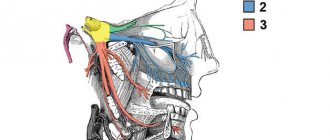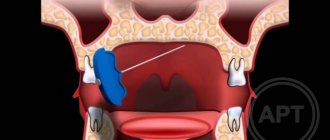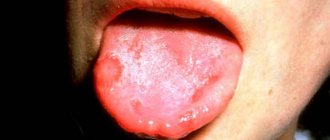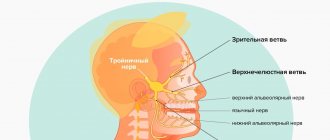Installation of implants is a surgical operation that is performed under anesthesia. Most often, local anesthesia is used, that is, eliminating the sensitivity of tissue in the area of the upcoming invasive manipulation. Since the anesthetic lasts for several hours, numbness after implantation is quite normal. It may be associated with swelling, which often accompanies the installation of artificial roots in the jaw. As a rule, the numbness goes away as soon as the effect of the drug wears off. But if sensory impairment persists several days after surgery, this may indicate the development of one of the complications.
Trigeminal nerve injury
Prolonged numbness of tissues after implantation can also be caused by incorrect selection of the length of implants or their installation without taking into account the anatomical characteristics of the patient. In this case, damage to one of the processes of the trigeminal nerve is possible. Most often, when screwing in dental implants, the inferior alveolar nerve is affected. If it is damaged in the area of the lower lip, cheek and gums (up to the second molars), the following may occur:
- complete numbness of tissues;
- not disappearance, but a violation of sensitivity, without other unpleasant phenomena;
- a change in sensitivity, which is accompanied by an abnormal reaction to certain stimuli and other pathological symptoms.
If the lingual nerve is damaged during implantation, the following may also appear along with numbness:
- uncontrolled tongue biting;
- increased salivation;
- loss of taste;
- swallowing dysfunction;
- difficulties with pronouncing sounds.
If such symptoms appear and prolonged loss of sensitivity after implantation, you should contact the dentist who performed the operation.
Why does paresthesia occur?
Decreased sensitivity in various parts of the body is called paresthesia. In dentistry, this pathological condition is associated with nerve damage.
Numbness after tooth extraction most often occurs if a wisdom tooth has been removed. This is due to the fact that the roots of the “eights” are located close to the nerve, which can be damaged due to:
- Traumatic tooth extraction (with its abnormal structure).
- Compression due to postoperative tissue swelling.
- Inaccurate actions of the dentist when administering an anesthetic.
Paresthesia most often occurs in patients over 25 years of age. Other factors that increase the risk of developing pathology include:
- history of neuralgia;
- cardiovascular pathologies;
- diseases of the endocrine system (including diabetes mellitus);
- lack of vitamins and minerals in the body;
- weak immunity.
Signs and symptoms
Complications after tooth extraction are indicated by long-term symptoms that persist for a week or more:
- Lack of sensitivity in a certain area of the face.
- Numbness of the tongue.
- Burning and tingling.
- Weakness of the jaw, inability to close the teeth completely.
- Partial or complete loss of taste.
- Increased salivation.
Helping the patient with numbness after implantation
During a consultation regarding the loss or disappearance of sensitivity after installation of an implant, the dentist first of all finds out the cause. To do this, a diagnostic study is carried out, which makes it possible to determine the type and degree of damage to the nerve fibers. Then a set of therapeutic measures is prescribed.
If therapy begins at an early stage of development of disorders, sensitivity can be restored more quickly. The rehabilitation program for each patient is drawn up individually, with the participation of a dentist, neurologist and physiotherapist.
Treatment usually includes medications and physiotherapeutic procedures, such as acupressure, acupuncture, electrophoresis, and ultraphonophoresis.
Diagnostics
The diagnosis is made by a neurologist. According to indications, the patient is referred to a dentist, maxillofacial surgeon or hematologist. To clarify the cause of chin numbness, the following diagnostic procedures are performed:
- Neurological examination
. With neuralgia, trigger points are determined at the exit points of the nerve branches. A comprehensive study of sensitivity, reflexes and muscle strength can detect neurological deficits indicating damage to brain structures. - Dental examination
. Informative for injuries, osteomyelitis of the jaw. It makes it possible to confirm the presence of a fracture and identify the disease that provoked the development of a pathological process in the bone. - Radiography
. In case of injuries of the maxillofacial area or osteomyelitis, photographs of the lower jaw are taken. If damage to the spinal column is suspected, an X-ray of the cervical spine is performed. - CT scan
. It is used to clarify the volume and localization of traumatic and inflammatory foci in the area of the skull and lower jaw, and to detect degenerative processes in the spine. Effective in identifying narrowing of the canals through which the trigeminal nerve passes. - Magnetic resonance imaging.
Recommended for cerebral tumors. Visualizes cysts and neoplasms. To confirm the vascular etiology of nerve compression, MR angiography is prescribed. - Lab tests
. For pernicious anemia, a biochemical blood test, tests for antibodies to intrinsic Castle factor and gastric parietal cells are indicated. In case of tumors, a morphological study is necessary to establish the nature and degree of differentiation of neoplasia. In inflammatory processes, culture of the discharge is required to determine the microflora.
Physiotherapy
Complications after local anesthesia
The human factor plays a big role in dental procedures. Often, the inexperience or carelessness of a specialist leads to serious consequences.
General complications that arise during local anesthesia in dentistry can be of different nature:
- Discomfort at the needle insertion site. This is due to the drug being administered too quickly or too slowly.
- Hematoma at the injection site. The occurrence and growth of a hematoma indicates problems with blood vessels or an incorrect choice of the needle insertion site.
- Allergic reactions. Despite the fact that reactions to drugs are determined before anesthesia, cases of severe allergies to the composition of the anesthesia are not uncommon, especially if it consists of two or more components.
- Inflammation of the gums, development of infection. This case suggests that several mistakes were made during the procedure, as a result of which bacteria entered unprotected tissue and caused inflammation.
- Numbness of the facial muscles. The symptom is often complicated to the point of paresis, lack of control over facial expressions, inability to close lips, and sagging areas of the face.
How to treat numb gums
If the patient's gums are numb, it is necessary to begin treatment early. The problem requires an integrated approach, since it is important to establish the cause of its occurrence.
The medications that are most often used if the gums are numb include:
- ► Antibacterial drugs. To eliminate pathogenic microflora in dentistry, Amoxiclav or Clindamycin are used. Preference is given to tablet or injection forms of release. The average duration of treatment is 7-14 days.
- ► Local antiseptics. They are used in the form of an ointment, gel or rinse solution.
- ► Non-steroidal anti-inflammatory drugs. The drugs reduce pain and tissue swelling. Nonsteroidal anti-inflammatory drugs are often taken for two weeks. The doctor selects medications individually.
- ► Traditional methods. A decoction of chamomile or calendula has a pronounced anti-inflammatory effect, which restores tissue sensitivity if the gums are numb. However, traditional methods can only be used on the recommendation of a dentist.
If there is no effect from the drug therapy, surgical intervention is prescribed, which is aimed at removing purulent masses or the implant. This will improve the patient's condition and prevent the spread of infection to other organs and tissues.
At the recovery stage, when the gums become numb, physiotherapeutic procedures are used:
- ► laser therapy
- ► dynamic current treatment
- ► UHF therapy
- ► electrophoresis
Complications of pulpitis without treatment
If pulpitis is not treated, the inflammation progresses, extends beyond the root canal, and affects adjacent periodontal and periodontal tissues. Most often this leads to periodontitis. Acute periodontitis is manifested by sharp pain, which is localized in the area of the affected tooth. The intensity of the pain gradually increases, it becomes throbbing when purulent inflammation begins. If treatment is not started at this stage, purulent exudate begins to separate, and the periodontal collagen fibers are destroyed. Soft tissues swell, temperature rises, and general condition worsens.
With periodontitis, the ligaments that hold the tooth in the alveolus are destroyed, and the destruction of bone tissue begins. The tooth becomes loose and falls out. Large cysts may appear.
Another possible complication of pulpitis is periostitis. With periostitis, inflammation spreads to the periosteum (tissue surrounding the bone), and a flux is formed. The gums swell and the jaw becomes painful. Periostitis can appear after pulpitis or accompany periodontitis. Without treatment, the swelling of the gums increases, the pain intensifies, the cheek and lip near the site of inflammation swell. The pain becomes shooting and can affect the temple, eye, ear. A fistula (passage) may appear in the swollen gum, through which pus comes out. After the fistula tract appears, the inflammation becomes less intense, but the tissues remain infected, and the infection continues to spread, and periostitis from an acute form becomes chronic.
Pulpitis can provoke the development of periodontitis - an inflammatory disease of the gums, dangerous by the destruction of bone tissue, gradual recession of the gums, and adentia. Against the background of acute inflammation and tissue infection, severe systemic diseases may appear: general sepsis (blood poisoning), phlegmon (breakthrough of pus into the soft tissues of the face, requiring surgical intervention), amyloidosis (occurs due to the constant toxic effect of pus).
Treatment
Conservative therapy
Treatment tactics depend on the causes of chin numbness. Patients with trigeminal neuralgia are prescribed anticonvulsants. The dosage is gradually increased until a therapeutic effect is achieved. Reception is continued for several months, and then the dose is gradually reduced. The regimen is supplemented with antihistamines, antispasmodics, and means to improve microcirculation. Blockades are performed according to indications. Among the effective physiotherapeutic techniques are diadynamic currents, galvanization, and ultraphonophoresis.
To relieve a migraine attack, NSAIDs are used; in severe cases, drugs from the triptan group are used. For repeated vomiting, antiemetics are used. To prevent paroxysms, long-term treatment with antidepressants and anticonvulsants is carried out. For herpes zoster, antiviral therapy is administered with acyclovir. Mental disorders are corrected with the help of psychotherapy, sometimes in combination with psychotropic drugs.
Antibiotics are indicated for wounds, open fractures, and osteomyelitis of the jaw. First, broad-spectrum antibacterial drugs are used, and later the medication is replaced taking into account the antibiotic sensitivity of the pathogen. Patients with pernicious anemia require lifelong treatment with B12 drugs, elimination of conditions that led to the development of vitamin deficiency.









